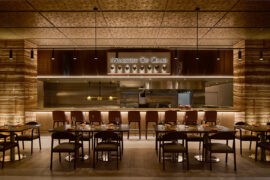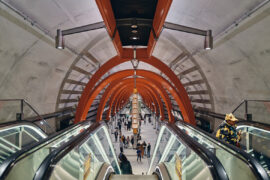Shangri-La have done the impossible and found space on prime Hong Kong harbourfront to open a resort called The Kerry Hong Kong.

The Kerry in Hong Kong’s Hung Hom district recently opened as the city’s first “urban resort,” and the flagship of Shangri-La’s new brand. The harbourfront hotel of 546 rooms, five restaurants, and a stunning infinity pool was designed by Rocco Design Architects with interiors by renowned homegrown designer Andre Fu. “What attracted me to take up the Kerry Hotel was the challenge to infuse a lifestyle hotel experience into a large-scale property,” says Fu.
Rocco Design placed the restaurants and leisure facilities on a series of cascading terraces stepping down in a non-linear format from the main block of rooms. The building and terraces are formed of sweeping curves that provide unobstructed sea views from the guest rooms. “The building form is sculpted by the desire to animate the waterfront, taking on a metaphorical imagery of a wavy ribbon to address the harbour,” says Rocco Design.
In the lobby, a curved 80-metre wall of undulating 8-metre high floor-to-ceiling windows shows off the view of the east side of Hong Kong’s Victoria Harbour. Four sculptural walls in Turkish onyx mimic the movement of water against warm beige botticino classic marble. The lobby’s furnishings are in mauve and mineral grey. Bronze is chosen as an accent with tall, lazer-cut bronze screens and vast bronze sculptures by Taiwanese artist Ju Ming.
Fu designed the guest rooms with a palette of eucalyptus timber, anodized bronze, and mineral blue carpeting with glossy lacquer panels. The portrait floor-to-ceiling windows make the most of the stunning harbour views. Look out for the pivot study lamp and the solid timber door pull-handles – two of Fu’s personal highlights in the guest rooms.
On the third floor, Big Bay Café is an exotic tropical restaurant that spills out onto a two-tier terrace overlooking the harbour and adjacent to the property’s stunning infinity pool. Inside, the 230-square-metre floor is a bright collage of 56,000 mango yellow, olive green, earthy brown, and navy blue tiles with seven pavilions constructed in walnut timber breaking up the space. On level seven, Cantonese restaurant Hung Tong recalls the dockyards of the past where the hotel once sat with red brick, natural cleft granite, and grey botticino marble walls furnished with rustic vintage carpets, leather chairs, heavy wooden shelving, and glass pendants.
Recalling the trading spirit of the former dockyard neighbourhood where the hotel sits, Hung Tong’s interiors draw inspiration from the traditional industrial brick warehouses that once dominated the Hung Hom Bay shoreline. The dining room features brick walls, vintage-inspired leather chairs, and tinted glass pendants. In the spirit of 1960s Hong Kong, the design includes metallic tilted window frames, wooden shelves, and rustic carpets.
“The greatest challenge was in balancing the needs of the common good and private good,” shares Rocco Design. The hotel integrates with an existing public waterfront promenade to the south and a planned urban park to the northwest. The design aims to balance perfect waterfront views and privacy for the guests but also preserve view corridors for the district. “This is a luxurious hotel with an embracing social agenda for all,” says Rocco Design.
INDESIGN is on instagram
Follow @indesignlive
A searchable and comprehensive guide for specifying leading products and their suppliers
Keep up to date with the latest and greatest from our industry BFF's!

For those who appreciate form as much as function, Gaggenau’s latest induction innovation delivers sculpted precision and effortless flexibility, disappearing seamlessly into the surface when not in use.

From the spark of an idea on the page to the launch of new pieces in a showroom is a journey every aspiring industrial and furnishing designer imagines making.

At the Munarra Centre for Regional Excellence on Yorta Yorta Country in Victoria, ARM Architecture and Milliken use PrintWorks™ technology to translate First Nations narratives into a layered, community-led floorscape.

In an industry where design intent is often diluted by value management and procurement pressures, Klaro Industrial Design positions manufacturing as a creative ally – allowing commercial interior designers to deliver unique pieces aligned to the project’s original vision.

Dreamily poetic in his approach to any project, Joe Cheng, director of CCD and UN Cultural Ambassador, has adopted the Fenghuang as the thematic touchstone for Shangri-La Nanshan.

We sit down with Andre Fu, a leader in creating bespoke projects defined by a seamless alignment of cultural and design sensibilities.

As a category The Luminary pays tribute to those who have contributed to enrich the architecture and design community throughout their working lives. With Wilkhahn as sponsor, this year there are three Luminaries who together represent the very best in design through their individuality, dedication and talent.
The internet never sleeps! Here's the stuff you might have missed

After more than two decades at Architects EAT, Eid Goh launches AIR, a new Melbourne-based studio focused on adaptive reuse, hospitality and human-centred design across commercial and civic projects.

A collaboration between Hassell, Weston Williamson + Partners (WW+P Architects) and Rogers Stirk Harbour + Partners (RSHP) sees the opening of five new underground stations.